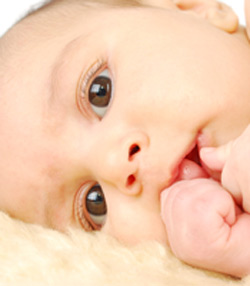What Does Your Baby See?

by Emily Lapkin
Infants aren’t born walking and talking, so it should come as no surprise that they aren’t born seeing perfectly, either. So what does baby see? Here’s the typical timeline that vision development follows:
WHAT BABY SEES: BIRTH TO 4 MONTHS
- Before 2 months, a baby’s eyes don’t always track together and may sometimes cross and wander, and that’s normal. (Parents should only be concerned if baby’s eyes never track together.)
- From birth to 3 months, a baby’s eyes cannot focus on objects that are more than 8-10 inches away from her face.
- At about 3 months, your baby should begin to follow moving objects with her eyes and reach for things.
WHAT BABY SEES: 5 MONTHS TO 1 YEAR
- By 5 months, your baby will have good color vision (though not as sensitive as an adult’s.)
- After 5 months, your baby’s eyes work together to see the world in three dimensions. Crawling, which may start around 8 months, helps further develop eye-hand coordination.
- Between 9 and 12 months, your baby should start using her eyes and hands together.
“Many times, vision problems are not obvious to parents and caregivers,” says Glen Steele, O.D., optometrist and professor at the Southern College of Optometry in Memphis, Tenn. For that reason, the American Optometric Association (AOA) recommends that parents take their children for a baseline eye exam between 6 and 12 months.
Free exams are available through the InfantSEE program, a public health effort from the AOA and Johnson & Johnson Vision Care Inc. (Visit the InfantSEE website to find an optometrist near you who offers this service.) Signs of a potential problem include tearing, not making eye contact, and missing social/emotional milestones (even though these are seemingly unrelated to vision.)
According to Steele, there’s a lot parents can do to stimulate their baby’s healthy vision development. His suggestions:
- Gaze into baby’s eyes.
Whenever your baby is awake and alert, get close to baby, look her in the eye and make sure she’s looking back. (“Try not to text or read or do other things when you’re feeding baby,” says Steele. It’s a great time for eye contact.) - Choose high-contrast toys.
Objects that are black-and-white or bright primary colors – and not pastels – are best to boost baby’s vision in the first six months. - Give baby tons of tummy time.
Tummy time not only helps develop baby’s neck and shoulder muscles, but also gives her a chance to visually explore her world. - Make sure baby gets balanced nutrition.
Breastfeed your baby, or look for formulas that offer the same vision-supporting nutrients found in breastmilk, including DHA and lutein.
Photo: @iStockphoto.com/MaxkateUSA
Emily Lapkin is a writer, editor and Web content specialist who has covered health and parenting topics for nearly two decades. She previously managed the health and wellness channels of iVillage.com and was editor in chief of BabyZone.com. Lapkin is the mom of two young daughters.




